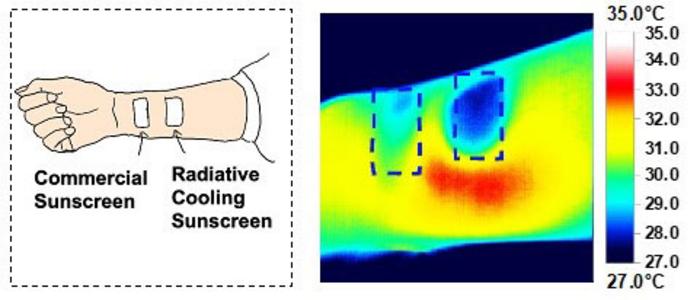A newly developed sunscreen protects against ultraviolet light from the Sun while keeping skin nice and cool, even in summer, with the prototype formula capable of more dramatic skin cooling compared to other commercially available sunscreens.
The approach, known as radiative cooling, has already been employed in creating cooling fabrics – as well as the whitest paint in the world, which is so effective at reflecting light that anything coated with it stays several degrees cooler than ambient temperature.
This sunscreen uses the same idea – harnessing the ability of certain substances to reflect light and heat to protect the skin. The prototype kept human skin 4.2-6°C (7.6-10.8°F) cooler than bare skin, and 2.3–6.1°C (4.14-11.0°F) cooler than commercially available sunscreens.

Their sunscreen is more effective at cooling the skin than other sunscreens.
The sunscreen has six ingredients: Deionized water, ethanol, Nivea cream, kaolin pigments, a silicone polymer called polydimethylsiloxane, and titanium dioxide nanoparticles. Titanium dioxide is already used in commercial sunscreens and the nanoparticles are considered safe for the skin – the formula did not cause skin irritation in the study.
It is the specifics of these nanoparticles that allowed the team to achieve the larger cooling effect. The team tweaked the size of the titanium dioxide nanoparticles so that they both reflect ultraviolet light and cause radiative cooling simultaneously. Their formula was measured to have a high SPF of 51. It was also waterproof, and remained effective for 12 hours of simulated sunlight using a xenon lamp used to simulate sunlight.
It was tested in a hot and humid environment to measure the radiative cooling effect. The formulation is also not very expensive – they estimate that it currently costs $0.92 for every 10 grams, which is similar to commercially available products. The team believes this has great promise of being commercialized and acting as a good way to protect people – which is ever more relevant as summers continue to get hotter due to the climate crisis.
The paper is published in the American Chemical Society journal Nano Letters.
Source Link: Prototype Sunscreen Keeps Skin Cooler While Shielding From UV Rays